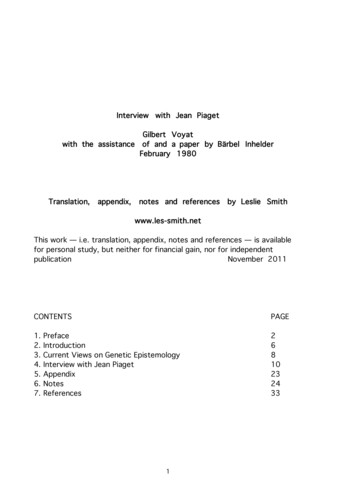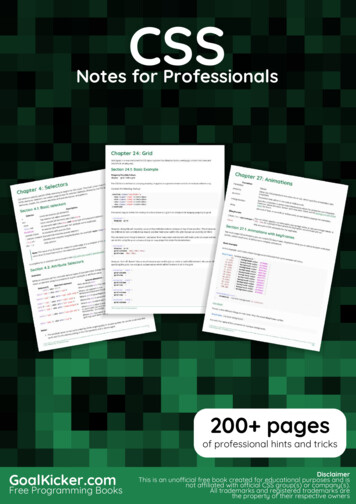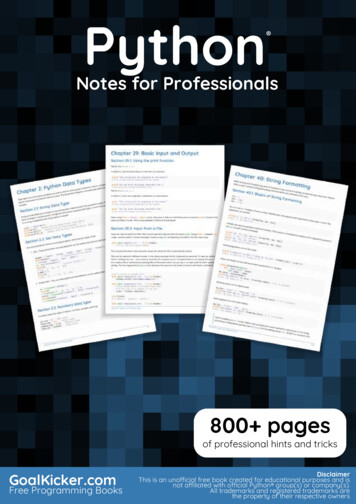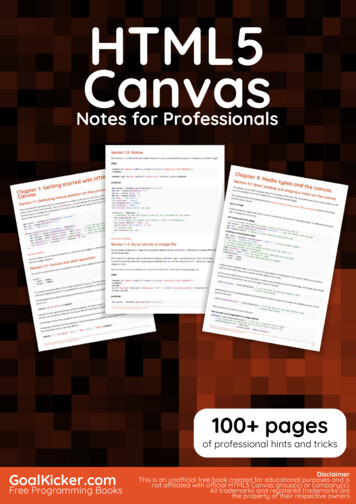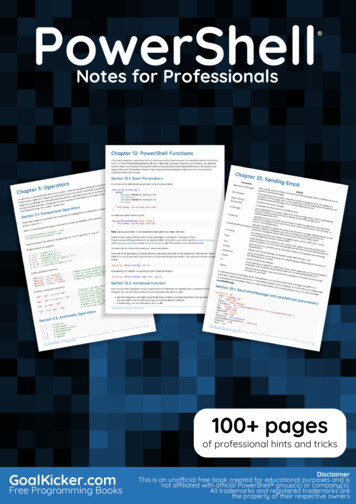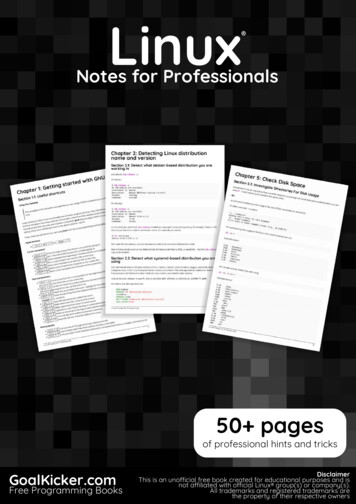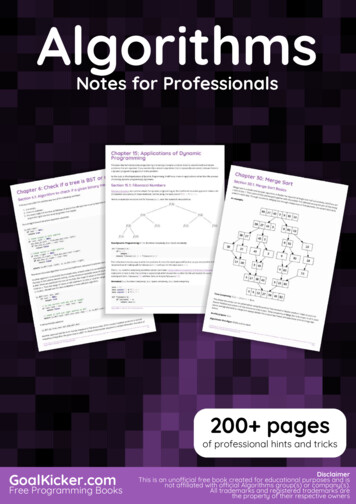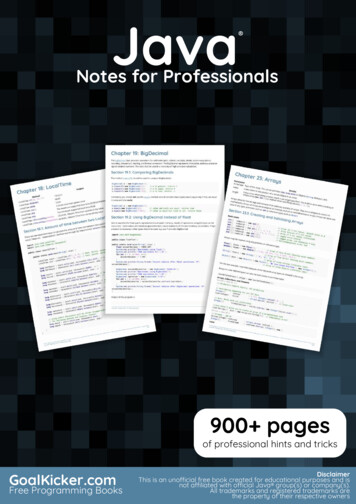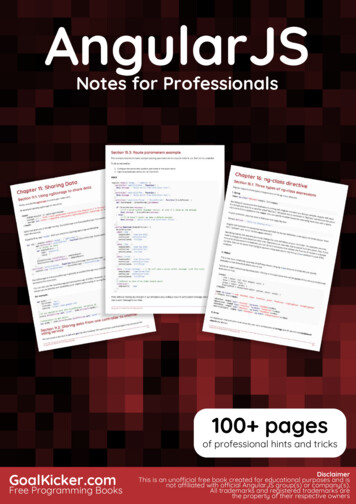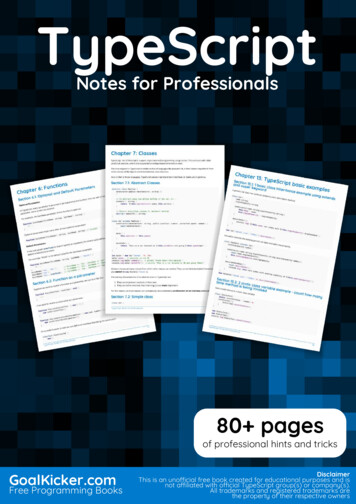
Transcription
TypeScriptTypeScriptNotes for ProfessionalsNotes for Professionals80 pagesof professional hints and tricksGoalKicker.comFree Programming BooksDisclaimerThis is an uno cial free book created for educational purposes and isnot a liated with o cial TypeScript group(s) or company(s).All trademarks and registered trademarks arethe property of their respective owners
ContentsAbout . 1Chapter 1: Getting started with TypeScript . 2Section 1.1: Installation and setup . 2Section 1.2: Basic syntax . 4Section 1.3: Hello World . 5Section 1.4: Running TypeScript using ts-node . 6Section 1.5: TypeScript REPL in Node.js . 6Chapter 2: Why and when to use TypeScript . 8Section 2.1: Safety . 8Section 2.2: Readability . 8Section 2.3: Tooling . 8Chapter 3: TypeScript Core Types . 9Section 3.1: String Literal Types . 9Section 3.2: Tuple . 12Section 3.3: Boolean . 12Section 3.4: Intersection Types . 13Section 3.5: Types in function arguments and return value. Number . 13Section 3.6: Types in function arguments and return value. String . 14Section 3.7: const Enum . 14Section 3.8: Number . 15Section 3.9: String . 15Section 3.10: Array . 16Section 3.11: Enum . 16Section 3.12: Any . 16Section 3.13: Void . 16Chapter 4: Arrays . 17Section 4.1: Finding Object in Array . 17Chapter 5: Enums . 18Section 5.1: Enums with explicit values . 18Section 5.2: How to get all enum values . 19Section 5.3: Extending enums without custom enum implementation . 19Section 5.4: Custom enum implementation: extends for enums . 19Chapter 6: Functions . 21Section 6.1: Optional and Default Parameters . 21Section 6.2: Function as a parameter . 21Section 6.3: Functions with Union Types . 23Section 6.4: Types of Functions . 23Chapter 7: Classes . 24Section 7.1: Abstract Classes . 24Section 7.2: Simple class . 24Section 7.3: Basic Inheritance . 25Section 7.4: Constructors . 25Section 7.5: Accessors . 26Section 7.6: Transpilation . 27Section 7.7: Monkey patch a function into an existing class . 28Chapter 8: Class Decorator . 29
Section 8.1: Generating metadata using a class decorator . 29Section 8.2: Passing arguments to a class decorator . 29Section 8.3: Basic class decorator . 30Chapter 9: Interfaces . 32Section 9.1: Extending Interface . 32Section 9.2: Class Interface . 32Section 9.3: Using Interfaces for Polymorphism . 33Section 9.4: Generic Interfaces . 34Section 9.5: Add functions or properties to an existing interface . 35Section 9.6: Implicit Implementation And Object Shape . 35Section 9.7: Using Interfaces to Enforce Types . 36Chapter 10: Generics . 37Section 10.1: Generic Interfaces . 37Section 10.2: Generic Class . 37Section 10.3: Type parameters as constraints . 38Section 10.4: Generics Constraints . 38Section 10.5: Generic Functions . 39Section 10.6: Using generic Classes and Functions: . 39Chapter 11: Strict null checks . 40Section 11.1: Strict null checks in action . 40Section 11.2: Non-null assertions . 40Chapter 12: User-defined Type Guards . 42Section 12.1: Type guarding functions . 42Section 12.2: Using instanceof . 43Section 12.3: Using typeof . 43Chapter 13: TypeScript basic examples . 45Section 13.1: 1 basic class inheritance example using extends and super keyword . 45Section 13.2: 2 static class variable example - count how many time method is being invoked . 45Chapter 14: Importing external libraries . 46Section 14.1: Finding definition files . 46Section 14.2: Importing a module from npm . 47Section 14.3: Using global external libraries without typings . 47Section 14.4: Finding definition files with TypeScript 2.x . 47Chapter 15: Modules - exporting and importing . 49Section 15.1: Hello world module . 49Section 15.2: Re-export . 49Section 15.3: Exporting/Importing declarations . 51Chapter 16: Publish TypeScript definition files . 52Section 16.1: Include definition file with library on npm . 52Chapter 17: Using TypeScript with webpack . 53Section 17.1: webpack.config.js . 53Chapter 18: Mixins . 54Section 18.1: Example of Mixins . 54Chapter 19: How to use a JavaScript library without a type definition file . 55Section 19.1: Make a module that exports a default any . 55Section 19.2: Declare an any global . 55Section 19.3: Use an ambient module . 56Chapter 20: TypeScript installing typescript and running the typescript compiler tsc . 57
Section 20.1: Steps . 57Chapter 21: Configure typescript project to compile all files in typescript. . 59Section 21.1: TypeScript Configuration file setup . 59Chapter 22: Integrating with Build Tools . 61Section 22.1: Browserify . 61Section 22.2: Webpack . 61Section 22.3: Grunt . 62Section 22.4: Gulp . 62Section 22.5: MSBuild . 63Section 22.6: NuGet . 63Section 22.7: Install and configure webpack loaders . 64Chapter 23: Using TypeScript with RequireJS . 65Section 23.1: HTML example using RequireJS CDN to include an already compiled TypeScript file . 65Section 23.2: tsconfig.json example to compile to view folder using RequireJS import style . 65Chapter 24: TypeScript with AngularJS . 66Section 24.1: Directive . 66Section 24.2: Simple example . 67Section 24.3: Component . 67Chapter 25: TypeScript with SystemJS . 69Section 25.1: Hello World in the browser with SystemJS . 69Chapter 26: Using TypeScript with React (JS & native) . 72Section 26.1: ReactJS component written in TypeScript . 72Section 26.2: TypeScript & react & webpack . 73Chapter 27: TSLint - assuring code quality and consistency . 75Section 27.1: Configuration for fewer programming errors . 75Section 27.2: Installation and setup . 75Section 27.3: Sets of TSLint Rules . 76Section 27.4: Basic tslint.json setup . 76Section 27.5: Using a predefined ruleset as default . 76Chapter 28: tsconfig.json . 78Section 28.1: Create TypeScript project with tsconfig.json . 78Section 28.2: Configuration for fewer programming errors . 79Section 28.3: compileOnSave . 80Section 28.4: Comments . 80Section 28.5: preserveConstEnums . 81Chapter 29: Debugging . 82Section 29.1: TypeScript with ts-node in WebStorm . 82Section 29.2: TypeScript with ts-node in Visual Studio Code . 83Section 29.3: JavaScript with SourceMaps in Visual Studio Code . 84Section 29.4: JavaScript with SourceMaps in WebStorm . 84Chapter 30: Unit Testing . 86Section 30.1: tape . 86Section 30.2: jest (ts-jest) . 87Section 30.3: Alsatian . 89Section 30.4: chai-immutable plugin . 89Credits . 91You may also like . 93
AboutPlease feel free to share this PDF with anyone for free,latest version of this book can be downloaded from:https://goalkicker.com/TypeScriptBookThis TypeScript Notes for Professionals book is compiled from Stack OverflowDocumentation, the content is written by the beautiful people at Stack Overflow.Text content is released under Creative Commons BY-SA, see credits at the endof this book whom contributed to the various chapters. Images may be copyrightof their respective owners unless otherwise specifiedThis is an unofficial free book created for educational purposes and is notaffiliated with official TypeScript group(s) or company(s) nor Stack Overflow. Alltrademarks and registered trademarks are the property of their respectivecompany ownersThe information presented in this book is not guaranteed to be correct noraccurate, use at your own riskPlease send feedback and corrections to web@petercv.comGoalKicker.com – TypeScript Notes for Professionals1
Chapter 1: Getting started with TypeScriptVersion Release Date2.8.32018-04-202.82018-03-282.8 RC2018-03-162.7.22018-02-162.7.12018-02-012.7 017-06-282.3.22017-04-282.3.12017-04-252.3.0 beta -072.2 9-222.0 5-01-131.32014-10-281.1.0.12014-09-23Section 1.1: Installation and setupBackgroundTypeScript is a typed superset of JavaScript that compiles directly to JavaScript code. TypeScript files commonly usethe .ts extension. Many IDEs support TypeScript without any other setup required, but TypeScript can also becompiled with the TypeScript Node.JS package from the command line.GoalKicker.com – TypeScript Notes for Professionals2
IDEsVisual StudioVisual Studio 2015 includes TypeScript.Visual Studio 2013 Update 2 or later includes TypeScript, or you can download TypeScript for earlierversions.Visual Studio CodeVisual Studio Code (vscode) provides contextual autocomplete as well as refactoring and debugging tools forTypeScript. vscode is itself implemented in TypeScript. Available for Mac OS X, Windows and Linux.WebStormWebStorm 2016.2 comes with TypeScript and a built-in compiler. [WebStorm is not free]IntelliJ IDEAIntelliJ IDEA 2016.2 has support for TypeScript and a compiler via a plugin maintained by the JetBrainsteam. [IntelliJ is not free]Atom & atom-typescriptAtom supports TypeScript with the atom-typescript package.Sublime TextSublime Text supports TypeScript with the TypeScript package.Installing the command line interfaceInstall Node.jsInstall the npm package globallyYou can install TypeScript globally to have access to it from any directory.npm install -g typescriptorInstall the npm package locallyYou can install TypeScript locally and save to package.json to restrict to a directory.npm install typescript --save-dev Installation channelsYou can install from:Stable channel: npm install typescriptBeta channel: npm install typescript@betaDev channel: npm install typescript@nextCompiling TypeScript codeThe tsc compilation command comes with typescript, which can be used to compile code.tsc my-code.tsThis creates a my-code.js file.Compile using tsconfig.jsonGoalKicker.com – TypeScript Notes for Professionals3
You can also provide compilation options that travel with your code via a tsconfig.json file. To start a newTypeScript project, cd into your project's root directory in a terminal window and run tsc --init. This commandwill generate a tsconfig.json file with minimal configuration options, similar to below.{"compilerOptions": {"module": "commonjs","target": "es5","noImplicitAny": false,"sourceMap": false,"pretty": true},"exclude": ["node modules"]}With a tsconfig.json file placed at the root of your TypeScript project, you can use the tsc command to run thecompilation.Section 1.2: Basic syntaxTypeScript is a typed superset of JavaScript, which means that all JavaScript code is valid TypeScript code. TypeScriptadds a lot of new features on top of that.TypeScript makes JavaScript more like a strongly-typed, object-oriented language akin to C# and Java. This meansthat TypeScript code tends to be easier to use for large projects and that code tends to be easier to understand andmaintain. The strong typing also means that the language can (and is) precompiled and that variables cannot beassigned values that are out of their declared range. For instance, when a TypeScript variable is declared as anumber, you cannot assign a text value to it.This strong typing and object orientation makes TypeScript easier to debug and maintain, and those were two ofthe weakest points of standard JavaScript.Type declarationsYou can add type declarations to variables, function parameters and function return types. The type is written aftera colon following the variable name, like this: var num: number 5; The compiler will then check the types (wherepossible) during compilation and report type errors.var num: number 5;num "this is a string";// error: Type 'string' is not assignable to type 'number'.The basic types are :number (both integers and floating point numbers)stringbooleanArray. You can specify the types of an array's elements. There are two equivalent ways to define array types:Array T and T[]. For example:number[] - array of numbersArray string - array of stringsTuples. Tuples have a fixed number of elements with specific types.[boolean, string] - tuple where the first element is a boolean and the second is a string.[number, number, number] - tuple of three numbers.GoalKicker.com – TypeScript Notes for Professionals4
{} - object, you can define its properties or indexer{name: string, age: number} - object with name and age attributes{[key: string]: number} - a dictionary of numbers indexed by stringenum - { Red 0, Blue, Green } - enumeration mapped to numbersFunction. You specify types for the parameters and return value:(param: number) string - function taking one number parameter returning string() number - function with no parameters returning an number.(a: string, b?: boolean) void - function taking a string and optionally a boolean with no returnvalue.any - Permits any type. Expressions involving any are not type checked.void - represents "nothing", can be used as a function return value. Only null and undefined are part of thevoid type.neverlet foo: never; -As the type of variables under type guards that are never true.function error(message: string): never { throw new Error(message); } - As the return type offunctions that never return.null - type for the value null. null is implicitly part of every type, unless strict null checks are enabled.CastingYou can perform explicit casting through angle brackets, for instance:var derived: MyInterface;( ImplementingClass derived).someSpecificMethod();This example shows a derived class which is treated by the compiler as a MyInterface. Without the casting on thesecond line the compiler would throw an exception as it does not understand someSpecificMethod(), but castingthrough ImplementingClass derived suggests the compiler what to do.Another way of casting in TypeScript is using the as keyword:var derived: MyInterface;(de
TypeScript TypeScript Notes for Professionals Notes for Professionals GoalKicker.com Free Programming Boo

